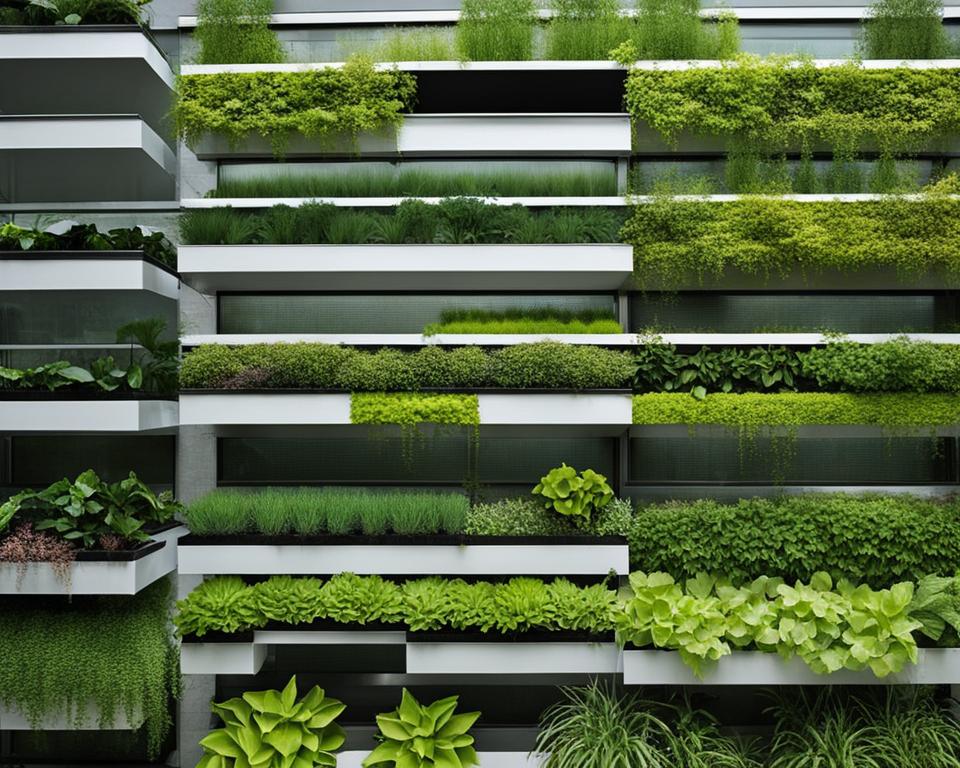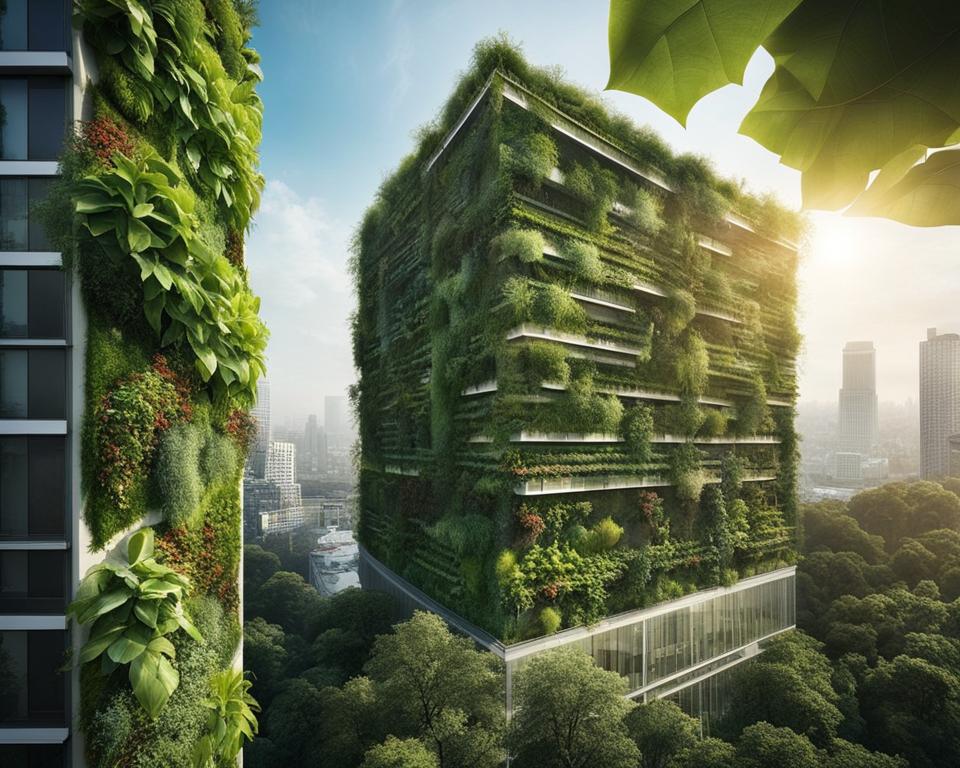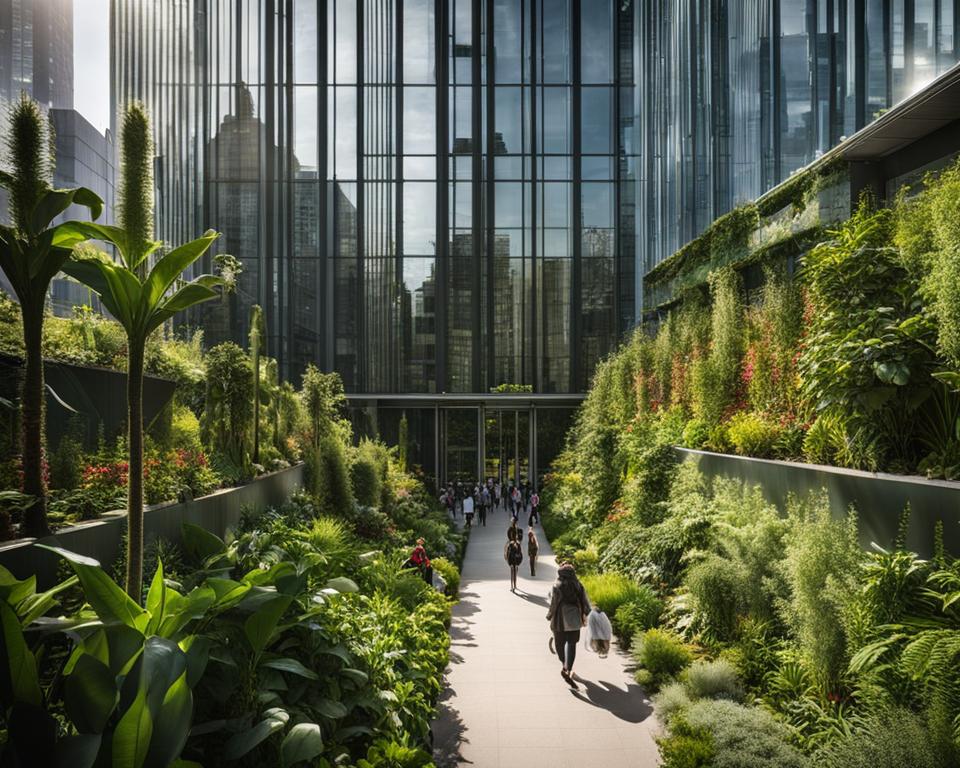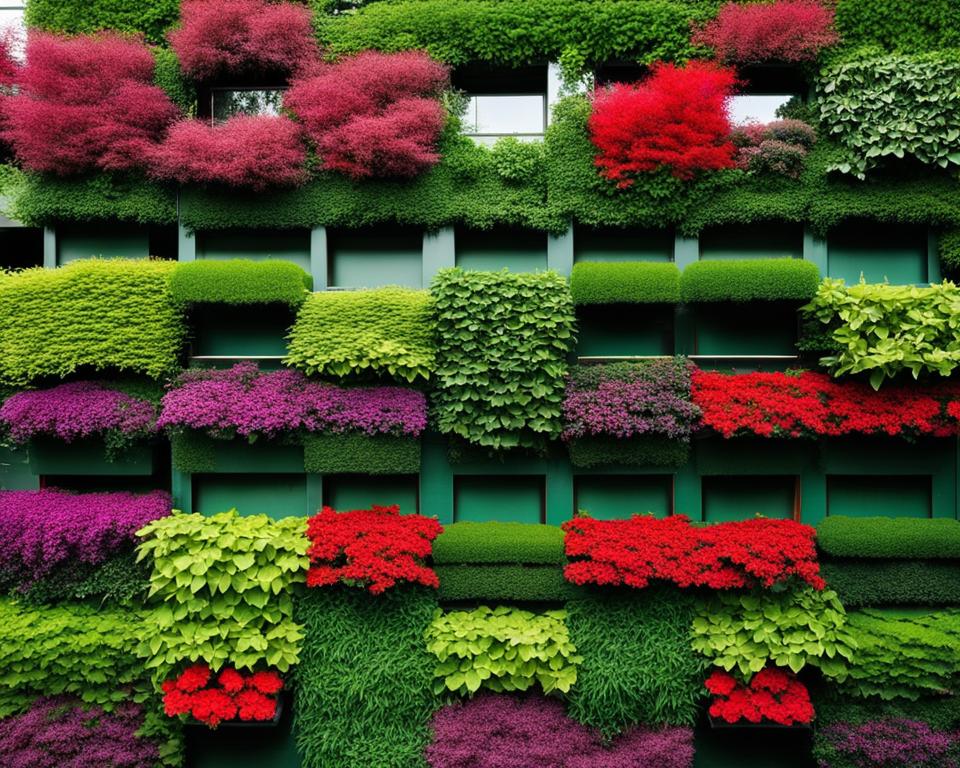Are you dreaming of a green sanctuary but feel constrained by the compact confines of your urban dwelling? Fear not! Vertical urban gardening is the innovative solution that’s revolutionizing the way we think about small space gardening. By embracing the vertical dimension, you can turn any wall or balcony into a vibrant garden, contributing to urban agriculture and sustainable living. Imagine the fusion of lush greenery with the convenience of city life, all while upholding principles of environmental sustainability. Vertical gardening allows you to grow upwards, nourishing your space – and spirit – with life.
Whether it’s a leafy herb nook in your kitchen or a floral cascade on your terrace, the possibilities are endless. Engaging in vertical gardening not only amplifies your available planting space but also transforms your living area into an eco-friendly haven bursting with life. It’s time to elevate your gardening game and infuse nature into every inch of your city life.
Key Takeaways
- Utilize vertical spaces to cultivate a lush garden in any urban area.
- Vertical gardening: a key practice aligning with sustainable, eco-conscious lifestyles.
- Become a part of the urban agriculture movement right from your balcony or wall.
- Turn your home into an eco-friendly oasis while practicing environmental sustainability.
- Small space gardening redefined: upwards growth equals more green in less ground.
Embracing Vertical Urban Gardening in Small Spaces
Have you thought about the possibilities that vertical gardening brings to your urban living space? Imagine turning that barren wall or the empty corner on your balcony into thriving patches of greenery. With urban plant cultivation practices, it’s not only possible—it’s a growing trend. Green walls, modular systems, and the creation of lush oases are not just dreams, but realities that can bloom even within the smallest of city spaces. Let’s delve into the wonders of this innovative gardening approach.
Perhaps you’re pondering how to get started with this vertical venture. Below are some effective techniques that can help you cultivate your green haven upward, transforming your residential area into a refreshing, natural retreat.
- Starting with wall planters can be an easy and beautiful way to introduce plant life on vertical surfaces.
- Looking for versatility? Modular systems offer the flexibility to arrange and rearrange your plants as your garden evolves over time.
- Using trellises can support a variety of climbing plants, adding depth and dynamic layers to your garden.
If you’re looking for additional inspiration, here’s a table exploring different modular systems available on the market that can help you sprout your vertical garden dreams into reality:
| Modular System | Type | Material | Recommended Plant Types |
|---|---|---|---|
| Eco Wall | Freestanding | Recycled Plastic | Ferns, Herbs, Small Flowers |
| Garden Tower | Stackable | Food-Grade Plastic | Vegetables, Edible Greens, Strawberries |
| Urban Frame | Wall-Mounted | Metal and Wood | Succulents, Ornamental Grasses, Small Perennials |
Whether it’s on a terrace or in an alleyway, vertical gardening allows you to express yourself through the cultivation of plants, from delicate flowers to hardy shrubs. It’s truly an alluring urban development that enables you to transform limited spaces into vibrant areas brimming with life. So why not start today and infuse your urban space with the serenity and beauty of nature?
Design Aesthetics: Enhancing Urban Landscapes with Vertical Elements

Urban gardening is revolutionizing city living, marrying functionality with visual appeal. By turning to the skies, these vertical structures not only optimize space but also create a green oasis amid concrete jungles. Let’s delve deeper into how to integrate these verdant enhancements in your urban landscape for a more pleasing visual aesthetic and a rich, diverse plant range.
Creating Focal Points with Green Walls
Green walls stand out as natural masterpieces, capturing the attention of onlookers and providing a breath of fresh air. They’re not limited to just private residences; public spaces too are emboldened with these living tapestries, turning bland structures into captivating landmarks. Whether it’s a small herb wall or a towering floral display, these vertical elements serve as both an environmentally conscious choice and an artistic statement in urban design.
Choosing Plants for Beauty and Visual Diversity
Selecting the right mix of plants is crucial for achieving the visual diversity and allure desired in any urban space. It’s about more than just aesthetics; the diversity of a plant range is key to cultivating a thriving ecosystem. Consider incorporating a combination of both flowering species for vivid colors and lush foliage plants for texture and variety. To aid in your selection, here’s a table outlining some ideal plant choices for urban green walls:
| Plant Type | Visual Appeal | Environmental Benefits |
|---|---|---|
| Ferns | Lush, verdant greenery | Improves humidity |
| Succulents | Diverse forms and colors | Drought-resistant |
| Edible Herbs | Textural variety | Encourages local food production |
| Flowering Perennials | Bright blooms across seasons | Attracts pollinators |
| Climbing Vines | Dynamic growth patterns | Creates shade and cooling effects |
Embrace the transformative power of urban gardening. By infusing your environment with a diverse plant range, tailored to create visual appeal, your venture into the world of vertical gardening promises to yield a captivating green oasis, no matter the scale of your urban canvas.
The Health Benefits of Urban Plant Cultivation

The concept of urban gardening has evolved beyond mere aesthetic value to a potent contributor to public health. Vertical gardens, a slicing edge of urban cultivation, have demonstrated their prowess in promoting wellness amidst concrete landscapes. Let’s delve into the tangible health benefits these verdant installations bring to our urban lives.
Purifying Air Quality with Vertical Gardens
One of the standout features of vertical gardens is their intrinsic ability to act as living air purifiers. In a time where urban air quality is compromising health, these green edifices serve a purpose of paramount importance. Each leafy strand functions as a natural filter, sifting out pollutants and returning the favor with a breath of purified air. It’s a symbiotic relationship between nature and urban dwellers, where increased oxygen levels equate to a healthier respiratory outlook for city inhabitants.
Improving Mental Well-Being Through Greenery
Metropolitan life is notorious for its hustle and demands, with stress as a frequent visitor for many. Urban gardening, particularly the vertical kind, weaves a fabric of tranquility over the urban environment. Engaging with plant life has been scientifically linked to mental health benefits such as stress reduction and heightened attention. The presence of green spaces can amplify cognitive function, fostering a sense of serenity and a boost in overall productivity.
| Aspect | Benefit | Vertical Gardens’ Role |
|---|---|---|
| Air Quality | Removal of air pollutants | Acts as biofilters to clean urban atmosphere |
| Oxygen Levels | Enhanced oxygen production | Photosynthesis increases ambient oxygen |
| Stress Levels | Reduced stress and anxiety | Visual exposure to greenery promotes relaxation |
| Productivity | Increased attention and productivity | Connection with nature improves focus and performance |
| Mental Health | Improved mental well-being | Green spaces offer therapeutic benefits |
Incorporating urban gardening into your daily life can thus translate into a multipronged health advantage. Whether it’s the improved air quality that vertical gardens foster or the stress reduction associated with immersing oneself in greenery, your pursuit of well-being aligns with the very vegetation that climbs the walls of your urban abode. So go ahead, invite nature into your home or office, and let increased productivity amidst an oasis of calm be your new norm.
Vertical Urban Agriculture: Cultivating Edibles Above Ground

Imagine stepping into your urban abode, surrounded by the lush vibrancy of organic fruits and vegetables. Through the wonders of urban farming, this vision is already blooming in cities across the nation. City inhabitants are redefining their relationship with food by cultivating edibles in their very own vertical gardens. This not only nurtures a personal connection with every fresh, crisp harvest but also champions sustainable gardening on a wider scale.
Locally sourced produce is no longer just a farmers market term; it’s a lifestyle. By leveraging the vertical plains of your living environment, you can enjoy the bounty of nature and significantly decrease the carbon footprint linked to transporting food. Here’s how you can get started with growing an astonishing variety of edibles right where you dwell:
- Identify which walls or structures can be converted into vertical farm space.
- Select a diverse array of plants, from leafy greens to bright berries, based on the local climate and sun exposure.
- Choose vertical gardening systems, like modular planters and trellises, that fit your space and aesthetic preferences.
It’s a tangible step towards a greener planet, starting with an individual commitment to elevate urban agriculture to new heights — quite literally. Nourish your body, refresh your mind, and heal the planet with every harvest, right from the comforts of your high-rise or backyard patio.
Climate Control: The Impact of Vertical Gardens on Urban Heat

As metropolitan areas continue to expand, the urban heat island effect becomes a growing concern. You might wonder, how can we mitigate the sweltering conditions that envelop our cities during the warmer months? The answer may be flourishing right before our eyes: vertical gardens. These living plant structures are not just visually appealing; they are instrumental in fostering energy conservation and offering natural cooling solutions.
Natural Insulation from the Urban Heat Island Effect
Imagine the walls of buildings clothed in lush greenery, each leaf working as a natural insulator. Vertical gardens offer a shield against the harsh heat generated by concrete and asphalt, known contributors to the urban heat island effect. By absorbing sunlight and reflecting less heat than traditional building materials, these plant-covered facades significantly reduce the temperature of the surrounding environment, ensuring your urban space stays cooler.
Cooling Benefits of Living Plant Structures
It doesn’t stop at insulation. The magic of vertical gardening includes the innate cooling process of plants—transpiration. By releasing water through their leaves, living plant structures act like natural air conditioners, reducing air temperature in their vicinity. In this way, vertical gardens can cool urban areas and diminish the reliance on mechanical cooling systems, which enhances energy conservation efforts and reduces electricity costs for you and your community.
Sustainable Gardening Practices in the Urban Jungle
As you embrace the vibrancy of urban life, you might wonder how to incorporate environmental conservation and sustainable gardening into your daily surroundings. The answer lies in vertical gardening—a method that maximizes resource efficiency and green space utilization without the need for extra land.
By integrating these living walls into our concrete landscapes, we do more than just beautify; we create a ripple effect of ecological benefits. From the flora that graces these structures, each leaf and petal plays an integral role in enhancing our urban ecosystems.
“In a time when urban spaces are increasingly constrained, vertical gardening stands tall as a beacon of resource efficiency and environmental conservation.” – Urban Horticulture Society
Here’s a look at how vertical gardens contribute to a sustainable urban environment:
- Water Conservation: With integrated drip irrigation systems, vertical gardens use water judiciously, targetting the root zones of plants and significantly reducing waste.
- Reduction of Urban Heat: Plants in vertical gardens contribute to cooling down the building facades, thereby lowering the overall city temperatures.
- Biodiversity Support: These structures provide critical habitats for numerous species, fostering a diverse urban wildlife.
But the benefits don’t stop there. Vertical gardens are at the forefront of a movement that reimagines how we interact with nature within our cities. They not only afford us the luxury of fresh, green vistas but also catalyze a deeper consciousness towards the natural world. Let’s dive into some specifics:
| Aspect of Sustainability | Benefits of Vertical Gardening |
|---|---|
| Air Quality Improvement | Plants filter pollutants and sequester carbon, providing us with cleaner air to breathe. |
| Energy Efficiency | The insulation provided by plant walls leads to reduced energy consumption for heating and cooling. |
| Psychological Well-being | Green spaces have been proven to reduce stress levels, contributing to mental health and productivity. |
In essence, embracing vertical gardening is a step towards sustainable living—a testament to human ingenuity in adapting to the challenges of urbanization. It represents a conscious choice for green space utilization, ensuring that every inch of our city landscapes is used to contribute positively to our environment and well-being.
Maximizing Your Green Footprint with Vertical Urban Gardening
As an urban dweller, you might be wondering how you can contribute to a greener planet amidst the concrete jungles. The answer lies in the innovative concept of vertical urban gardening. This practice allows you to transform your vertical space into vibrant, lush gardens that do more than just beautify the cityscape—they enhance water efficiency, promote urban biodiversity, and facilitate habitat creation.
Efficient Use of Water and Space
With the adoption of vertical urban gardening, you’re making incredible strides in water conservation. Advanced irrigation systems designed for vertical gardens, ensure that water is distributed evenly and with minimal waste. This means every precious drop is used to nurture your green haven. Beyond water savings, you are also maximizing your living space, as this ingenious method requires only a fraction of the footprint needed for traditional gardening.
Supporting Urban Biodiversity with Vertical Habitats
Urban biodiversity is critical for maintaining a balanced ecosystem, and vertical gardens are a testament to this fact. They provide a sanctuary for a variety of city-dwelling species. Whether you’re seeking to attract pollinators or create a haven for birds, your vertical garden serves as a beacon of life in urban settings. Through the creation of these vertical habitats, you are laying the groundwork for a vibrant and diversified urban ecosystem that supports life in all its forms.
In essence, by integrating vertical urban gardening into your lifestyle, you’re not only enhancing the beauty of your surroundings but also forging a path to a more sustainable urban future. So, roll up your sleeves and turn those bare vertical spaces into robust pillars of greenery, where every plant adds to your green footprint and fosters a healthier, more sustainable city life.
Creative Urban Garden Designs for Optimizing Space
When you’re looking to infuse life and color into your urban dwelling, harnessing the potential of urban garden design is essential. Living in the city doesn’t mean you have to forsake greenery and the joys of gardening. With the savvy use of container gardening, every balcony and windowsill transforms into a green haven. But why stop there? Take your green thumb to new heights with rooftop gardening, crafting an escape from the urban buzz right atop your building.
Creative space optimization is the goal, and urban gardeners are achieving it in unique and innovative ways. Multipurpose furniture items that act as both a cozy seating area and a home for your plants are no longer just a dream; they’re a chic, tangible reality. You can turn an old bookshelf or a pallet into an upright garden feature that not only saves space but also creates an engaging point of interest in your apartment.
Here’s how you can apply these concepts:
- Utilize hanging planters to make the most of vertical spaces.
- Choose stackable and nesting containers that can be rearranged as your garden grows and evolves.
- Implement self-watering systems to maximize water efficiency and ensure the health of your garden, even with a busy schedule.
- Explore modular gardening kits – they’re perfect for individualizing your space and can be expanded or adapted as needed.
- Repurpose common household items as plant containers for an eco-friendly approach.
Rooftop and balcony gardens do more than beautify; they become your private retreat for relaxation and reconnecting with nature. Integrate container gardening to grow your own herbs and vegetables, ensuring that even your culinary adventures have a touch of freshness you can take pride in. Whether it’s choosing the right containers or planting hardy varieties suited for your urban environment, every step brings you closer to creating an oasis amidst the concrete and steel.
Remember, taking on urban gardening is not just about utility — it’s about innovation and fulfillment. It’s about turning your living space into a testament to your commitment to green living and sustainability. So start small, dream big, and let your garden be the canvas for your most creative space optimization efforts.
Embracing a Greener Future in Urban Landscapes
As our cities grow ever taller and more densely packed, the need for creative solutions to maintain a connection with nature becomes ever more pressing. Vertical urban gardening experts have risen to this challenge, demonstrating that even the most urbanized world can house pockets of verdant life. This innovative approach to urban plant cultivation signifies more than a mere trend; it’s a lifestyle choice, fostering a green lifestyle that benefits both the environment and the soul.
Thanks to the ingenuity and passion of dedicated gardeners and urban planners, vertical green spaces are redefining the character of our cities, offering a reprieve from concrete and glass. They represent not just aesthetic enhancements, but keystones in the movement towards sustainable living. Allowing us to reap the psychological and physical rewards of interacting with greenery, vertical urban gardening paves the way to a greener, more sustainable future, one terrace and rooftop at a time.
Vertical gardens are the breath of fresh air in our cityscapes, offering a lush escape that feeds our innate desire for green spaces while promoting ecological responsibility.
Whether it’s through edible gardens that reduce our carbon footprint or flowering trellises that support local wildlife, each vertical garden contributes to a global effort to reconcile city life with ecological principles. Adapting our spaces to embrace nature speaks to a profound societal shift, a refreshing chapter in city living that brings the serenity of nature into our everyday experiences.
- Eco-Conscious Aesthetics
- Psychological Benefits of Nearby Nature
- Sustainable Food Production
- Urban Wildlife Support
- Improved Air and Life Quality
As we look ahead, the vision of connection with nature in urban environments is not just a utopian dream. It’s an achievable reality, cultivated by the hands of individuals and communities committed to evolution in urban living. By integrating nature into the architectural skeleton of our cities, vertical urban gardening plays a key role in nurturing this green future, sustaining our planet and our spirits alike. Let the cascade of foliage that adorns our city walls be a testament to humanity’s innate ability to harmonize with nature, even in the unlikeliest of places.
Get Started with Vertical Urban Gardening Today
Embark on the rewarding journey of creating your very own vertical oasis. With vertical urban gardening, the green haven of your dreams is just within reach. Imagine turning the blank canvas of your urban space into a lush, vibrant garden that not only revitalizes your surroundings but also supports sustainable living. By working with landscaping experts and utilizing innovative garden design techniques, you can transform any small space into a thriving hub for plants and wildlife.
Whether your aim is to forge a serene sanctuary where you can unwind, or to cultivate a garden brimming with edible delights, the path to achieving these vertical gardening dreams is clear. And there’s no need to feel daunted by the process—professional garden designers are at your service, ready to guide you from design inspiration to the flourishing finish. Their expertise will empower you to make informed decisions, ensuring that your vertical garden is not only beautiful but also environmentally friendly and resource-efficient.
Your aspirations of crafting a green haven are fully attainable with the right support. Connect with specialized landscaping experts who can bring your vision to life, tailoring the project to your unique needs and preferences. Step forward with confidence, ready to make a positive impact on both your life and the planet’s wellbeing. Seize the opportunity to immerse yourself in the art of vertical urban gardening and watch as the walls around you bloom with vitality and charm.
FAQ
What is vertical urban gardening?
Vertical urban gardening is a method of cultivating plants in a vertical orientation, utilizing walls and other upright structures to create gardens in areas with limited space. It’s a sustainable practice that turns urban spaces into lush, green environments while promoting environmental sustainability.
How can I start vertical gardening in a small urban space?
You can start by choosing the right location, such as a balcony, a wall, or even a windowsill, and then selecting appropriate vertical garden planters like modular systems, green walls, or trellises. Opt for plants that thrive in your local climate and suit the light conditions of your space. There are also beginner-friendly DIY vertical garden kits available to ease you into it.
Can vertical gardens really help improve air quality in my home?
Absolutely! Vertical gardens can enhance the quality of indoor air by absorbing pollutants and emitting oxygen. The plants act as natural air filters, contributing to a healthier living environment. Plus, the addition of green spaces can bring psychological benefits such as stress reduction and increased focus.
What kinds of plants are best for creating a visually diverse vertical garden?
For visual diversity, choose a mix of foliage shapes, colors, and textures. Variegated leaves, colorful flowers, and cascading plants can create an engaging visual display. Consider the growth patterns and maintenance needs of each plant to ensure a cohesive and stunning vertical garden.
Is it possible to grow edible plants in a vertical urban garden?
Yes! You can grow a variety of edible plants including herbs, leafy greens, and some fruits and vegetables, depending on the available light and the vertical garden’s structure. It’s a great way to have fresh, locally sourced produce right at your fingertips.
How do vertical gardens impact urban temperatures and climate?
Vertical gardens can help mitigate the urban heat island effect by providing shade and facilitating evapotranspiration, which cools the surrounding air. The plants in vertical gardens also offer natural insulation against heat, reducing the need for air conditioning in buildings.
What sustainable gardening practices are integrated into vertical urban gardening?
Vertical urban gardening employs sustainable techniques including efficient water usage, such as drip irrigation or self-watering systems, and space conservation by taking advantage of vertical surfaces. It encourages biodiversity and reduces the carbon footprint associated with transporting food.
How does vertical gardening support urban biodiversity?
By creating vertical habitats, urban gardens can attract and sustain diverse wildlife, such as beneficial insects, birds, and pollinators. Each garden becomes part of a larger green network, contributing to the overall health of the urban ecosystem.
What are some creative design solutions for urban gardens to optimize space?
Creative design solutions include using multipurpose furniture that doubles as planters, implementing container gardens for balconies and rooftops, and incorporating hanging planters to utilize even the smallest of spaces effectively. Vertical gardens can also turn functional areas into beautiful green retreats.
How do I find professional help to design and install a vertical urban garden?
You can find professional landscaping experts or garden designers specializing in vertical gardening through local gardening centers, online databases, or social media. Look for someone with experience in urban spaces, and be sure to check their portfolio and customer testimonials before making your choice.

